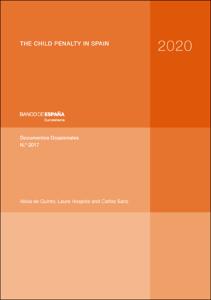The child penalty in Spain
Autor
Fecha de publicación
16-jul-2020
Descripción física
20 p.
Resumen
La literatura ha documentado extensamente el papel de la maternidad en la brecha salarial
de género. Utilizando datos de la Muestra Continua de Vidas Laborales de la Seguridad
Social, adoptamos la metodología utilizada en trabajos previos realizados en otros países
para evaluar la existencia de una penalización por hijo en España, analizando diferencias
entre hombres y mujeres en su perfil de ingresos tras el nacimiento del primer hijo.
Nuestros resultados muestran que los ingresos laborales de las mujeres caen un 11 % en
el primer año tras el nacimiento. Sin embargo, los ingresos de los hombres apenas se
ven afectados por la paternidad. Este impacto diferencial es aún mayor diez años después
del nacimiento. Nuestra estimación de la penalización por hijo a largo plazo es del 28 %,
similar en magnitud a la encontrada en Suecia y Dinamarca, y menor que la de Reino Unido,
Estados Unidos, Alemania y Austria. Además, identificamos los factores que pueden
contribuir a esta brecha, como la reducción del número de días trabajados y cambios
a empleos a tiempo parcial o con contrato temporal. Por último, encontramos que las
respuestas en términos de ingresos y participación laboral varían con el nivel educativo:
las mujeres con educación universitaria reaccionan a la maternidad más en el margen intensivo (trabajando a tiempo parcial), mientras que las mujeres sin educación universitaria son relativamente más propensas a hacerlo en el margen extensivo (trabajando menos días).
The role of parenthood in the gender pay gap has been extensively discussed in the literature. Using data from social security records, we adopt the methods used for other countries to evaluate the existence of a child penalty in Spain, looking at disparities for women and men across different labor outcomes following the birth of the first child. Our findings suggest that, the year after the first child is born, mothers’ annual earnings drop by 11 percent while men’s remain unaffected. The gender gap is even larger ten years after the birth. Our estimate of the long-run child penalty in earnings equals 28 percent, similar in magnitude to that found for Sweden and Denmark, and smaller than in the UK, the US, Germany, and Austria. In addition, we identify channels that may drive this phenomenon, including reductions in working days and shifts to part-time or fixed-term contracts. Finally, we encounter heterogeneous responses in earnings and labor market participation by educational level: college-educated women react to motherhood more on the intensive margin (working part-time), while non-college-educated women are relatively more likely to do so in the extensive margin (working fewer days).
The role of parenthood in the gender pay gap has been extensively discussed in the literature. Using data from social security records, we adopt the methods used for other countries to evaluate the existence of a child penalty in Spain, looking at disparities for women and men across different labor outcomes following the birth of the first child. Our findings suggest that, the year after the first child is born, mothers’ annual earnings drop by 11 percent while men’s remain unaffected. The gender gap is even larger ten years after the birth. Our estimate of the long-run child penalty in earnings equals 28 percent, similar in magnitude to that found for Sweden and Denmark, and smaller than in the UK, the US, Germany, and Austria. In addition, we identify channels that may drive this phenomenon, including reductions in working days and shifts to part-time or fixed-term contracts. Finally, we encounter heterogeneous responses in earnings and labor market participation by educational level: college-educated women react to motherhood more on the intensive margin (working part-time), while non-college-educated women are relatively more likely to do so in the extensive margin (working fewer days).
Publicado en
Documentos Ocasionales / Banco de España, 2017
Materias
Género; Participación laboral; Empleo; Diferenciales salariales; Paternidad; Nivel educativo; Gender; Labor supply; Employment; Wage differentials; Parenting; Education; Relaciones laborales; Mercado de trabajo; España
Aparece en las colecciones:












